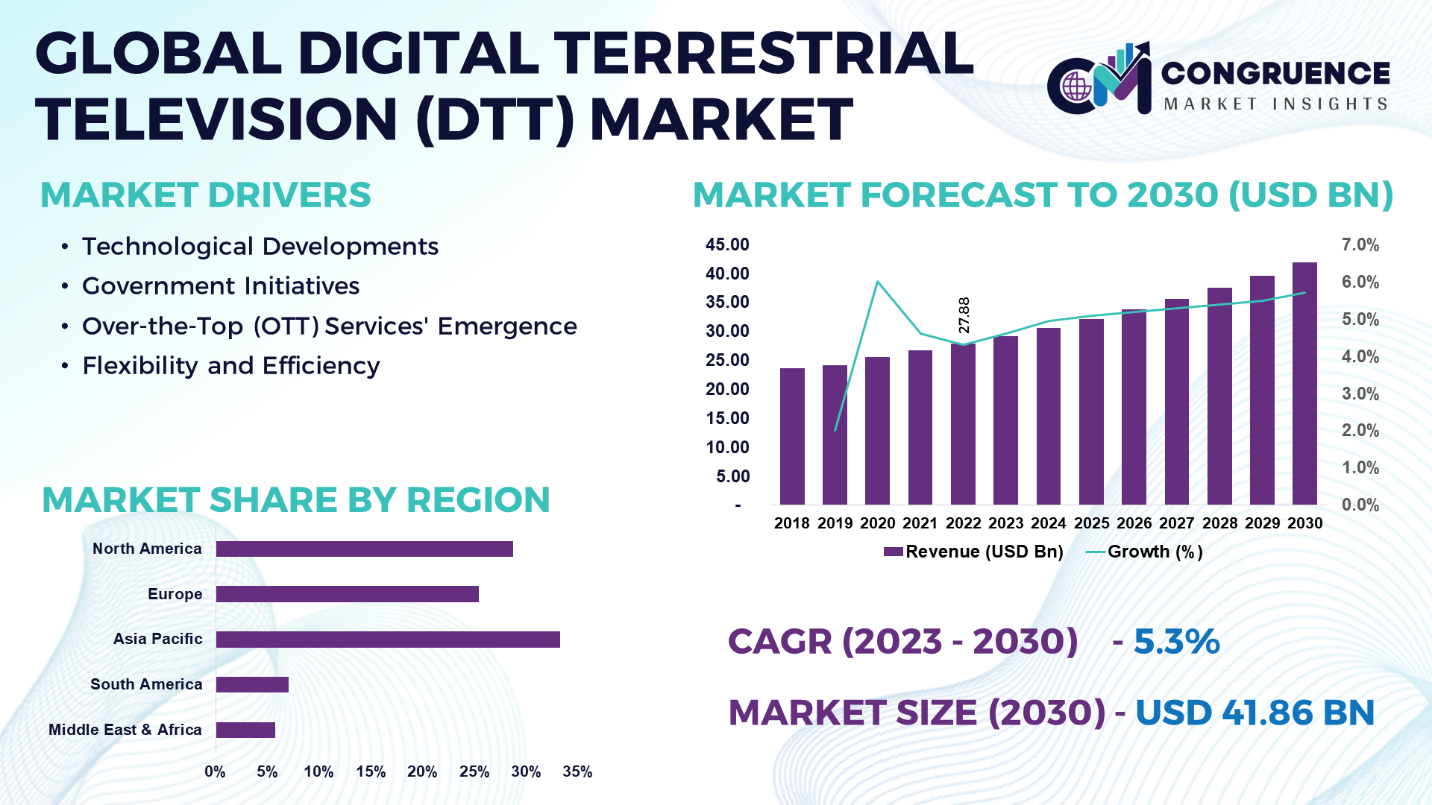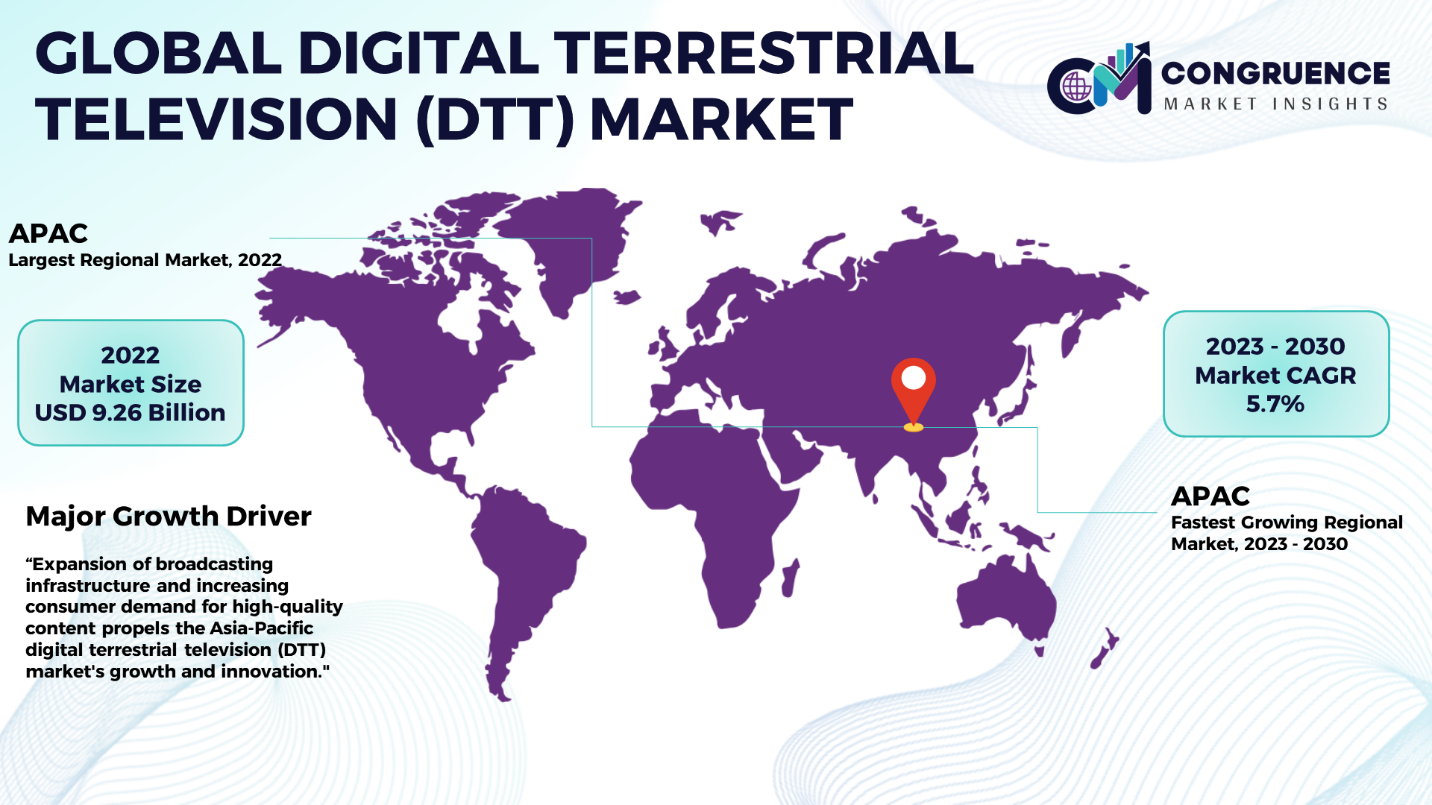Reports
The Global Digital Terrestrial Television (DTT) Market was valued at USD 27.88 Billion in 2022 and is anticipated to reach a value of USD 41.86 Billion by 2030 expanding at a CAGR of 5.3% between 2023 and 2030.
Terrestrial television transmission in a digital format is known as digital terrestrial television, or DTT. By utilizing digital technology, DTT is able to broadcast many channels with the same bandwidth used by a single analog channel, providing better picture and sound quality. With the advancement of television broadcasting technologies, audiences can now access a greater range of interactive services and programming. Government regulations requiring analog switch-off, rising demand for high-definition content, and the expansion of digital infrastructure are the main forces behind this. These elements play a major role in the global growth of DTT, as does the allure of watching television broadcasts over the air for free or at a reduced price compared to cable or satellite services. The high expense of broadcasters' infrastructure transitions and the competition from other digital broadcasting services, such as satellite and internet-based platforms, are limitations, nevertheless. Main obstacles include navigating the complicated regulatory regimes of many nations or regions and preserving signal integrity in heavily populated or geographically difficult areas. Another major problem is keeping up with user expectations while continuously upgrading technology. Technological developments in compression and transmission that allow for more effective utilization of the spectrum are examples of emerging prospects. Additionally, there is a chance to incorporate online and interactive services, which would give viewers better viewing experiences and broadcasters additional sources of income.

To learn more about this report, request a free sample
copy
Digital Terrestrial Television (DTT) Market Major Driving Forces
Technological Developments: The switch from standard definition to high definition broadcasting is just one example of the major technological developments that have affected the digital terrestrial television business. This change has enhanced the distribution of material and given viewers a more engaging experience.
Government Initiatives: The switch from analog to digital terrestrial television has received strong support from governments all over the world. In order to encourage the adoption of digital television broadcasting, these activities comprise developing legislative frameworks, granting tax benefits, and providing subsidies.
Over-the-Top (OTT) Services' Emergence: The market for digital terrestrial television has been disrupted by the growth of over-the-top services including streaming platforms and video-on-demand services. The advantages of traditional broadcasting are combined with the ease of on-demand programming in hybrid models that are the result of industry players adapting by including these services into their offers.
Flexibility and Efficiency: DTT's efficient transmission is attracting broadcasters, who are using it to enhance the flexibility and efficiency of their broadcast infrastructure and turn it into a strategic component of their operations. Consequently, propelling the digital terrestrial television market.
Digital Terrestrial Television (DTT) Market Key Opportunities
Investing in Cutting-Edge Technology: Cutting-edge technology, such virtual reality, interactive features, and 4K broadcasts, may offer a distinctive and engaging watching experience. To remain at the forefront of technological innovations, industry players are spending in research and development, which presents a significant opportunity for market growth.
Increased Regional Expansion: As nations that have not yet made the entire switch to digital broadcasting catch up, the market for digital terrestrial television is expanding more regionally. As more people have access to digital terrestrial television services, this expansion will help the market thrive.
Internet Protocol (IP) Technology Integration: Broadcasters will be able to offer hybrid services, a combination of the advantages of traditional broadcasting and the interactivity and ease of internet-based content delivery, once IP technologies are integrated with digital terrestrial television transmission. Industry participants will have new opportunities as a result of this convergence.
Digital Terrestrial Television (DTT) Market Key Trends
· Move toward broadcasting standards for high-definition (HD) and ultra-high-definition (UHD).
· The use of integrated hybrid broadcast-broadband (HBBTV) services is growing.
· Growth of hybrid DTT/OTT services and Over-The-Top (OTT) streaming platforms.
· Next-Gen TV standards evolution, including ATSC 3.0 and DVB-T2.
· Growing consumer demand for portable DTT devices and mobile TV.
· Expansion of programs for the digital transition in developing nations.
· Incorporation of cutting-edge technologies such as interactive apps and Electronic Program Guides (EPGs).
· Make the switch to more sophisticated compression methods for effective use of the available spectrum.
· Advent of immersive audio-visual experiences with 4K transmission.
· For mobile broadband, there is a growing emphasis on spectrum reallocation and efficiency.
Region-wise Market Insights
Asia Pacific accounted for the largest market share at 33.2% in 2022 whereas, it is also expected to register the fastest growth, expanding at a CAGR of 5.7% between 2023 and 2030.

To learn more about this report, request a free sample
copy
The Asia-Pacific region dominates the global digital terrestrial television (DTT) market with the market share of 33.2% worldwide. The region is also expected to grow at the fastest rate with CAGR 5.7% during the projected time frame. The market in this region is driven by the expansion of broadcasting infrastructure and increasing consumer demand for high-quality content. Large disposable income along with the huge population in countries such as China, India, South Korea and Japan, there is a massive market for the global digital terrestrial television market to grow. Additionally, partnerships between broadcasters and OTT platforms fuel market growth and innovation in Asia Pacific. DTT is frequently used in North America (NA) owing to its accessibility and high-quality transmissions. Market expansion is driven by the region's highly developed broadcasting infrastructure as well as consumer demand for ultra-high definition (UHD) and high definition (HD) programming. The European market has experienced tremendous growth and development due to a number of positive aspects that are widespread in the region. Many European nations have made the successful transition from analog to digital broadcasting, placing them at the forefront of the digital shift.
Market Competition Landscape
The competitive landscape in the digital terrestrial television (DTT) market is dynamic and ever-changing. A plethora of entities, ranging from established industry titans to innovative startups, contend for domination and market share. Tough competition fosters a continuous quest for innovation and outstanding performance as businesses aim to set themselves apart via better product quality, pricing strategies, and customer happiness. Variables including new developments in technology, changes in regulations, and shifting customer tastes all influence market dynamics. In addition to pushing market expansion, this dynamic rivalry presents opportunities and challenges for players, encouraging strategic alliances, mergers, and acquisitions as companies try to stay ahead of the curve in this ever-changing landscape. The digital terrestrial television (DTT) industry, in general, offers an exciting range of competition, where success depends heavily on one's capacity to adapt and generate new ideas. Leading companies in the industry include:
· Samsung Electronics Co., Ltd.
· LG Electronics Inc.
· Sony Corporation
· Panasonic Corporation
· Toshiba Corporation
· Sharp Corporation
· Philips Electronics N.V. (Koninklijke Philips N.V.)
· Hisense Group
· Haier Group Corporation
· TCL Technology Group Corporation
· Skyworth Group
· Vestel Elektronik Sanayi ve Ticaret A.Ş.
· Changhong Electric Co., Ltd.
· Grundig Intermedia GmbH
· Funai Electric Co., Ltd.
|
Report Attribute/Metric |
Details |
|
Market Revenue in 2022 |
USD 27.88 Billion |
|
Market Revenue in 2030 |
USD 41.86 Billion |
|
CAGR (2023 – 2030) |
5.3% |
|
Base Year |
2022 |
|
Forecast Period |
2023 – 2030 |
|
Historical Data |
2018 to 2022 |
|
Forecast Unit |
Value (US$ Mn) |
|
Key Report Deliverable |
Revenue Forecast, Growth Trends, Market Dynamics, Segmental Overview, Regional and Country-wise Analysis, Competition Landscape |
|
Segments Covered |
· By Device Type (Television Sets, Set-Top Boxes, Others) · By Broadcasting Standard (ATSC, DVB-T, ISDB-T, Others) · By Application (Residential, Commercial) |
|
Geographies Covered |
North America: U.S., Canada and Mexico Europe: Germany, France, U.K., Italy, Spain, and Rest of Europe Asia Pacific: China, India, Japan, South Korea, Southeast Asia, and Rest of Asia Pacific South America: Brazil, Argentina, and Rest of Latin America Middle East & Africa: GCC Countries, South Africa, and Rest of Middle East & Africa |
|
Key Players Analyzed |
Samsung Electronics Co., Ltd., LG Electronics Inc., Sony Corporation, Panasonic Corporation, Toshiba Corporation, Sharp Corporation, Philips Electronics N.V. (Koninklijke Philips N.V.), Hisense Group, Haier Group Corporation, TCL Technology Group Corporation, Skyworth Group, Vestel Elektronik Sanayi ve Ticaret A.Ş., Changhong Electric Co., Ltd., Grundig Intermedia GmbH, Funai Electric Co., Ltd. |
|
Customization & Pricing |
Available on Request (10% Customization is Free) |
